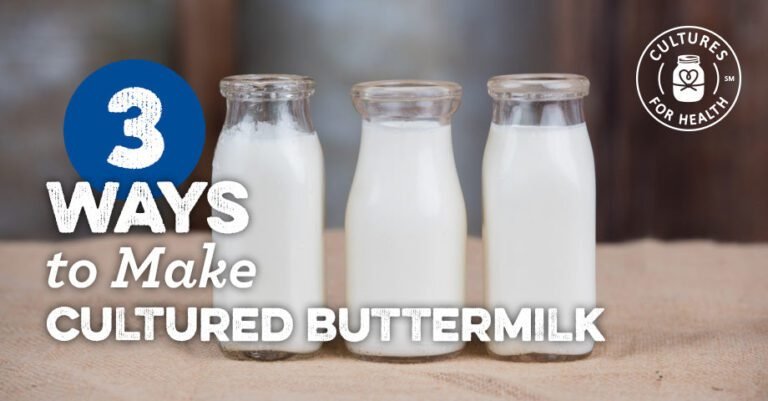3 Ways to Make Cultured Buttermilk – Cultures for Health
– | / Save up to % keep Save up to % keep Sale Sold Out In Stock
Cultured Buttermilk VS. Traditional Buttermilk
Did you know that cultured buttermilk, also known as buttermilk culture, is actually different from traditional buttermilk?
The residual liquid from making butter is known as traditional buttermilk. It can be consumed as a drink or added to recipes in place of water for added nutritional value.
Cultured buttermilk, on the other hand, is commonly used in recipes, such as:yogurt Because it is made using live beneficial bacteria. This buttermilk culture can be consumed as a thick, creamy drink, used in cooking, or made with buttermilk. cultured buttermilk starter.
Download our yogurt guide and recipe book now Start making your favorite recipes using cultured buttermilk!
Why make it homemade?
Of course, you can also go to the store and buy a carton of buttermilk to add to your recipes.
But there’s something special about making cultured buttermilk at home. Not to mention, when you make it at home, you have control over the ingredients used in the final product.
So, if you decide to try culturing buttermilk, here are three ways to do it. We have summarized the advantages and disadvantages of each, so you can choose the method that best suits your lifestyle.


Option #1: How to use an heirloom buttermilk starter to culture buttermilk
One common way to culture buttermilk at home is to use an heirloom buttermilk starter. This traditional method of making your own cultured buttermilk is the most economical. All you need is an initial starter culture and fresh milk.
This heirloom culture makes batches of traditional cultured buttermilk on your countertop as easy as pouring milk into a jar. Baked with buttermilk or added to cream to make cultured butter. What the bag contains: 2 packs of buttermilk starter culture solution Instructions for each step of using the culture solution…
Strong Points
You only need to purchase one. With proper care, this starter culture can be used indefinitely to make cultured buttermilk.
Cons
You should maintain your nutrition by making buttermilk (even in small amounts) every week.
Steps Part 1: Activate the cultured buttermilk starter

pour Place 1 quart of pasteurized milk in a glass or plastic container.

addition 1 pack of starter cultures.


cover Secure a towel or coffee filter to the container with a rubber band, cover on the container and culture In a warm place 70° to 77°F.

check rear 24 hours Check to see if the buttermilk has curdled. If not set, leave to 48 hours, I check it every few hours.
Tilt the container slightly. If the buttermilk clumps away from the sides of the jar instead of running up the sides, it’s solidified.
Once set or after 48 hours. cover A sturdy lid and refrigerate At least 6 hours.

Instructions Part 2: How to make cultured buttermilk!

How to get started Combine 1/4 cup of buttermilk from previous batch Container contains 1 quart of pasteurized milk.

cover Secure a towel or coffee filter to the container with a rubber band, put Cover the container and culture In a warm place 70°-77°F, 12-18 hours.

check Check to see if the incubation is complete by gently tilting the bottle every few hours. Once the buttermilk has solidified, cover Cover tightly and store at least in the refrigerator 6 hours.
rear 6 hours, Cultured buttermilk is edible, but remember to reserve it 1/4 cup To culture the next batch!
Tip: To make large batches, up to 1/2 gallon per container, use 1 tablespoon buttermilk for every cup of milk.
Option #2: Make cultured buttermilk using directly set sour cream starter
Direct-set starters are for one-time use and typically come in multiple packets per box, allowing you to make multiple batches. Our Sour Cream Starter Culture contains 4 packets. Here are some optional steps to make buttermilk with it. Click here to visit us Directly set sour cream starter culture.
Incubating buttermilk using a sour cream starter that sets directly is another option. This is a one-time use box with multiple packets in it, so you can make multiple batches.
Strong Points
It’s very easy to use. There is no mother culture to maintain. Store the pack in the freezer and remove it whenever you’re ready to make buttermilk.
Cons
Direct-set starters can only be used once and cannot be re-incubated or can be re-incubated only a limited number of times.
Steps for making cultured buttermilk using sour cream starter culture
heat 1 to 4 quarts pasteurized milk to 185°F and wait a while 30-60 minutes. nice to 77°F. addition 1 packet of starter culture. Stir gently until completely dissolved. transfer in glass or plastic containers. cover Secure it with a towel or coffee filter, secure it with a rubber band, or cover it with a lid. place In a warm place 74°-77°F, to culture 16-18 hours. Once set, cover A sturdy lid and Refrigerate.
Option #3: How to make a more cultured buttermilk using commercially available cultured buttermilk.
This method utilizes cultured buttermilk, which is easily available at local stores, to culture more buttermilk.
Strong Points
Easily available from local stores.
Cons
Usage is limited and you need to have buttermilk on hand to make more buttermilk. (Commercial buttermilk usually cannot be re-cultured many times.)
Instructions
mix 1/3 cup Use commercially available buttermilk containing live active bacteria. 1 cup fresh milk. cover loosely Culture in warm places (70° to 77°F) Let stand until thickened, 12 to 24 hours. Please refrigerate.
Try this homemade buttermilk recipe
For beginners interested in learning how to make cultured buttermilk, it’s important to note that the process is actually quite simple and rewarding. In addition to yielding a delicious and nutritious product, the process of culturing buttermilk also allows you to utilize ancient food preparation techniques. Throughout history, people have cultivated buttermilk as a way to preserve milk and enhance its nutritional properties. By cultivating buttermilk at home, you are participating in this rich tradition.
It’s also worth noting that the type of milk used in the process can affect the flavor and consistency of the resulting cultured buttermilk. Pasteurized milk is most commonly used, but you can try different types of milk, including goat milk. Each variety brings a unique taste and texture to the finished product, adding extra fun to the process of making cultured buttermilk at home.
Ready to learn more?
{“themeColor”:”#7892a4″,”iconColor”:”#7892a4″,”showLogo”:false,”topBottomPosition”:10,”rightLeftPosition”:10,”iconSize”:”large”,”iconCustomSize”:64 ,”position”:”top left”}


